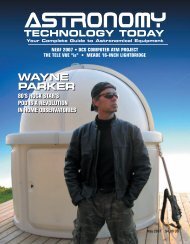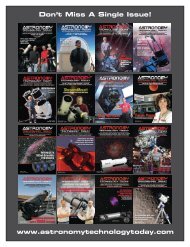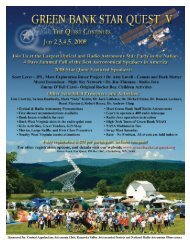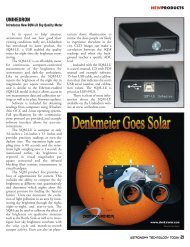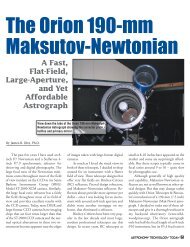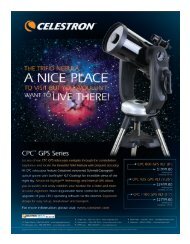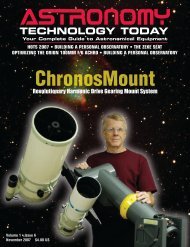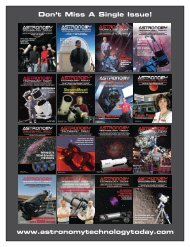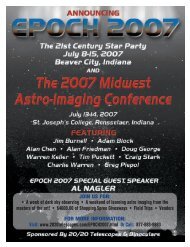iOPTRON - Astronomy Technology Today
iOPTRON - Astronomy Technology Today
iOPTRON - Astronomy Technology Today
Create successful ePaper yourself
Turn your PDF publications into a flip-book with our unique Google optimized e-Paper software.
M-UNO: A PIER-LESS MOUNT<br />
tion protocol. In addition to the USB hardwire<br />
connection, the M-Uno can be controlled<br />
wirelessly through the built-in<br />
Bluetooth connection using a similarly<br />
equipped laptop, or even an iPhone or Android<br />
equipped with Sky Safari. Luciano<br />
also advised me that a Linux version of the<br />
control software is in development that will<br />
run on Ubuntu 12.04 LTS. Being a Linux<br />
guy, I couldn’t help but be impressed. How<br />
many mount manufacturers are writing<br />
control software for Linux? None that I<br />
know of.<br />
The control panel has three auxiliary<br />
ports to control external devices. For autoguiding,<br />
the control panel has an RJ-11<br />
port for a standard ST-4 interface that accepts<br />
commands from the guiding camera<br />
without an intervening optocoupler. In addition,<br />
the control panel has dedicated<br />
ports to enable remote operation of a<br />
DSLR and the Baader Steeltrack focuser<br />
(using the hand paddle). The mount’s<br />
firmware is updatable over the Internet.<br />
The M-Uno runs on 12-volt DC from the<br />
supplied AC adapter or from a 12-volt battery<br />
in the field where AC power is not<br />
available.<br />
The most obvious difference between<br />
the M-Uno’s design and that of GEM and<br />
fork mounts is what it looks like in the<br />
parked position. When parked, the arm<br />
lays at an angle equal to the mount’s latitude<br />
location, with the polar finder scope<br />
mounted in the shoulder and pointing up<br />
through the wrist at the celestial pole. It reminded<br />
me of an arm-wrestling contestant<br />
getting ready for a match. The M-Uno also<br />
has an optional external polar finder scope<br />
that attaches to a dovetail milled into the<br />
side of the arm with a removable stainlesssteel<br />
holder. The standard polar finder<br />
scope is the Vixen design, but an optional<br />
adapter for the Losmandy-style polar finder<br />
scope is available.<br />
I think the first of the M-Uno’s radical<br />
functions is that polar alignment is done<br />
first before placing the instrument on the<br />
saddle when using the internal polar finder<br />
scope. Once the payload is attached, the<br />
s t a i n l e s s - s t e e l<br />
clutch levers may<br />
be carefully released<br />
to check the<br />
instrument’s balance.<br />
The M-Uno<br />
has a listed capacity<br />
of 25 kilograms<br />
(55 pounds), although<br />
for imaging,<br />
20 kilograms<br />
(44 pounds) is recommended.<br />
For<br />
heavier payloads,<br />
counterweights are<br />
required to balance<br />
the load in RA, but due to the single-arm<br />
design, they can be much smaller and<br />
lighter than those required by a GEM.<br />
Avalon offers stainless-steel counterweights<br />
of up to 30 kilograms (66 pounds) total.<br />
The arm’s position relative to the<br />
shoulder can be adjusted in order to alter<br />
the center of gravity of a heavier payload<br />
Image 4 - The M-Uno's “Fast Reverse” drive: a tooth belt-pulley system.<br />
and make balancing the load easier. The<br />
M-Uno can support lighter payloads without<br />
using any counterweights. None were<br />
needed for the payload Luciano brought to<br />
WSP. The user can balance the payload on<br />
the declination axis in the same manner as<br />
a GEM by sliding the payload back and<br />
forth on the saddle. Despite its robust ca-<br />
<strong>Astronomy</strong> TECHNOLOGY TODAY 45



